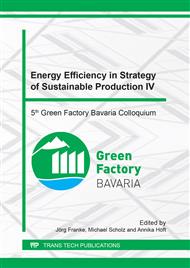[1]
Denso Corporation: Integrated Report 2017. URL https://www.denso.com/ global/en/news/investors/2017/2017_integrated_report.pdf – Überprüfungsdatum 2018-03-23.
Google Scholar
[2]
Stuiver, W.: Kendrion - Annual Report 2017: Simplify, Focus, Growth. URL https://publish.folders.eu/fixed/2016288?token=262d7f1713fb1b7112545c00f629103e&pageMode=single – Überprüfungsdatum 2018-03-23.
Google Scholar
[3]
Kallenbach, E.: Elektromagnete : Grundlagen, Berechnung, Entwurf und Anwendung. 4., überarbeitete und erweiterte Auflage. Wiesbaden : Vieweg+Teubner Verlag, (2012).
Google Scholar
[4]
Chen, C. H.; Higgins, A. K.; Strnat, R. M.: Effect of geometry on magnetization distortion in closed-circuit magnetic measurements. In: Journal of Magnetism and Magnetic Materials 320 (2008), Nr. 9, L84-L87.
DOI: 10.1016/j.jmmm.2008.01.035
Google Scholar
[5]
Baumbach, J. ; Kallenbach, E. ; Kucera, U. ; Neumann, K. ; Radler, O.: MagHyst-modular : Ein universelles Gerät zur Messung magnetischer Größen und Kennlinien an Materialien, Halbzeugen und Magnetaktoren. URL http://www.stz-mtr.de/stz-mtr/de/maghyst-de/publikationen-de/item/maghyst-modular-ein-universelles-geraet-zur-messung?category_id=2 – Überprüfungsdatum 2018-03-23.
Google Scholar
[6]
Scharff, P. (Hrsg.): Mechanical engineering from macro to nano - Ein neuartiges Verfahren zur Messung magnetischer Bauteile und Magnetaktoren : In: 50. Internationales Wissenschaftliches Kolloquium, 19. - 23.9.2005 ;. Ilmenau : Verl. ISLE, (2005).
Google Scholar
[7]
Radler, O. ; Rosenbaum, S. ; Ströhla, T. ; Kallenbach, E. ; Gadyuchko, A. ; Kucera, U. ; Baumbach, J. ; Zöppig, V. ; Rausch, T. ; Wittig, K.-H.: Influence of Magnetic Materials on the Function of Electromagnetic Actuators. In: 11th International Conference on New Actuators, 2008, S. 441–444.
Google Scholar
[8]
Gutfleisch, O.; Willard, M. A. ; Brück, E. ; Chen, C. H. ; Sankar, S. G. ; Liu, J. P.: Magnetic materials and devices for the 21st century : Stronger, lighter, and more energy efficient. In: Advanced materials (Deerfield Beach, Fla.) 23 (2011).
DOI: 10.1002/adma.201002180
Google Scholar
[9]
Rosenbaum, S.; Ströhla, T.; Kallenbach, E. ; Janschek, K.: Entwurf elektromagnetischer Aktoren unter Berücksichtigung von Hysterese. Zugl.: Ilmenau, Techn. Univ., Diss., 2011. Ilmenau, Ilmenau: Univ.-Bibliothek; Univ.-Verl. Ilmenau, 2011 (Ilmenauer Schriften zur Mechatronik 2).
DOI: 10.11129/detail.9783955530396.152
Google Scholar
[10]
Schoppa, A. ; Schneider, J. ; Wuppermann, C.-D: Influence of the manufacturing process on the magnetic properties of non-oriented electrical steels. In: Journal of Magnetism and Magnetic Materials 215-216 (2000), S. 74–78.
DOI: 10.1016/s0304-8853(00)00070-6
Google Scholar
[11]
Bretschneider, J. ; Wilde, A. ; Schneider, P. ; Hohe, H-P. ; Koehler, U.: Design of multi-dimensional magnetic position sensor systems based on HallinOne® technology. In: 2010 IEEE International Symposium on Industrial Electronics (ISIE 2010) : IEEE, 2010, S. 422–427.
DOI: 10.1109/isie.2010.5637864
Google Scholar
[12]
Bretschneider, J.; Wilde, A. ; Obenhaus, T.: Entwurf multidimensionaler Positionssensorik auf Basis von HallinOne(R)-Technologie : In: Simulation technischer Systeme (STS), Grundlagen und Methoden in Modellbildung und Simulation (GMMS) ; 4.-5. März 2010, S. 199–206.
Google Scholar
[13]
Hackner, M.; Hohe, H-P.; Stahl-Offergeld, M.: Im Messbetrieb kalibrierbarer magnetischer 3D-Punktsensor. Fraunhofer-Gesellschaft zur Förderung der angewandten Forschung. Anmeldenr. DE200610037226. Veröffentlichungsnr. DE102006037226 B4.
Google Scholar
[14]
Heyder, A.; Losch, T. ; Meyer, A.; Abersfelder, S.; Franke, J.: Comparison analysis of the magnetic field and the magnetic force inside of an electromagnetic actuator with the use of an armature measuring sensor. In: 2016 6th International Electric Drives Production Conference (EDPC): IEEE, 2016, S. 262–265.
DOI: 10.1109/edpc.2016.7851343
Google Scholar
[15]
Grima Cintas, P.; Marco-Almagro, L.; Tort-Martorell Llabres, J.: Industrial statistics with Minitab, John Wiley & Sons, Chichester, West Sussex, U.K., (2012).
Google Scholar


